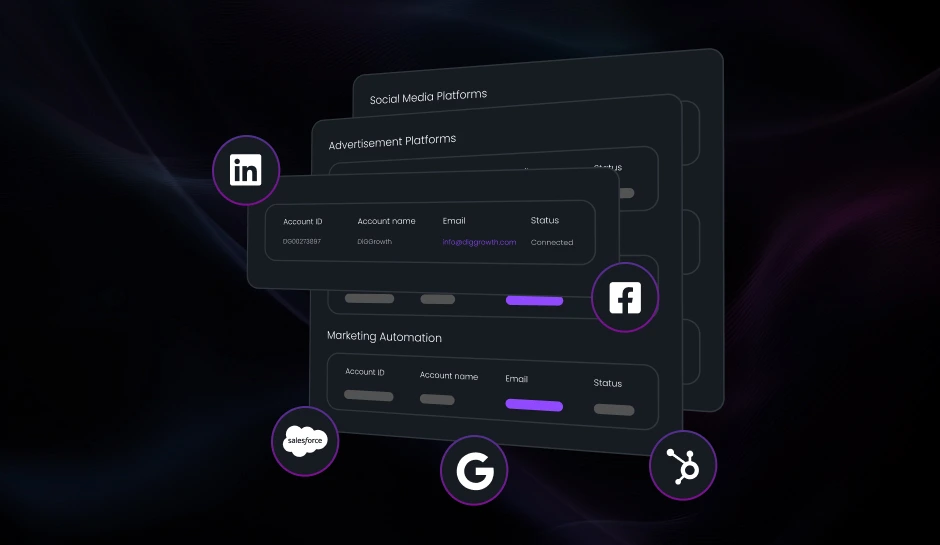
Harnessing the True Value of Enterprise Data Integration in the Modern Business Landscape
Efficient data flow is crucial for driving business success, but many organizations struggle with fragmented systems that slow down operations. Enterprise data integration tackles this challenge by connecting various platforms, allowing real-time access to accurate information. In this blog, we’ll delve into how businesses can harness the power of data integration to streamline workflows, improve decision-making, and foster long-term growth.
Organizations are collecting more data than ever, but managing and leveraging this data effectively has become a significant challenge. Disparate data systems, fragmented sources, and siloed departments often hinder the ability to extract actionable insights. This disconnect creates inefficiencies, slows decision-making processes, and impacts business agility.
This is where Enterprise Data Integration (EDI) steps in. By unifying data from multiple sources into a single, coherent system, EDI enables businesses to streamline operations, enhance data accuracy, and make informed decisions faster. But beyond these operational improvements, EDI has become a strategic necessity—fueling innovation, supporting scalability, and driving digital transformation efforts.
This blog will explore how enterprise data integration shapes businesses’ futures and why it’s no longer just a technical solution but a strategic enabler for long-term success.
What Is Enterprise Data Integration?
At its core, Enterprise Data Integration (EDI) is the process of unifying data from multiple disparate sources across an organization into a centralized system. This enables seamless data flow between departments, systems, and processes, providing businesses with a single source of truth.
Traditionally, data was siloed—locked within specific departments or software applications, making it difficult for organizations to get a holistic view of their operations. This led to fragmented reporting, inefficient workflows, and missed opportunities. EDI integrates data from sources like CRM, ERP systems, cloud platforms, and even IoT devices to ensure accessibility and consistency.
The Evolution of Data Integration
Data integration has transformed significantly, evolving from isolated systems to a more cohesive approach that empowers organizations to leverage their data effectively.
In the early days of computing, businesses operated with siloed systems, where each department maintained its databases. This fragmentation led to inefficiencies, as critical data was trapped in isolated systems, making it difficult for teams to access the needed information. As the value of data became evident, organizations began to seek integration solutions. Early efforts focused on basic data transfer mechanisms and middleware, enabling some connectivity but often requiring significant IT resources.
Key Benefits of Enterprise Data Integration
- Improved Decision Making:
- Enhanced Operational Efficiency:
- Increased Customer Satisfaction:
- Enhanced Compliance:
EDI provides a unified view of data, enabling businesses to make informed decisions based on accurate and up-to-date information.
EDI can significantly improve operational efficiency and reduce costs by streamlining data processes and eliminating manual tasks.
EDI can help organizations better understand customer needs and preferences, improving customer experiences and increasing satisfaction.
EDI can help businesses ensure compliance with data privacy regulations and industry standards.
Enterprise Data Integration Challenges and Best Practices
- Data Quality:
- Scalability:
- Integration Complexity:
Ensuring data accuracy and consistency is a critical challenge in EDI. Implementing data quality management practices and data cleansing tools can help address this issue.
As businesses grow and data volumes increase, EDI solutions must be scalable to handle the growing demands. Cloud-based EDI platforms can offer flexibility and scalability.
Using a well-defined integration architecture and leveraging integration platforms can simplify the process.
Emerging Trends in Enterprise Data Integration
- AI and Machine Learning:
- Cloud-Based EDI:
- Data Mesh:
AI and ML can automate data integration tasks, improve data quality, and uncover hidden patterns in data.
Cloud-based EDI solutions offer flexibility, scalability, and reduced infrastructure costs.
A data mesh architecture decentralizes data ownership and management, empowering teams to manage their data while ensuring interoperability.
How Enterprise Data Integration Powers Strategic Decisions
Having the ability to integrate and leverage it across all business functions has become a strategic necessity. Enterprise Data Integration (EDI) does more than connect systems; it empowers organizations to make decisions based on a holistic, real-time view of their data. Here’s how EDI enables smarter, faster, and more strategic decision-making:
Breaking Down Data Silos for Actionable Insights
Siloed data—where information is trapped within specific departments or systems—is among the most common barriers to effective decision-making. When data isn’t shared across the organization, decision-makers often work with incomplete or conflicting information, leading to:
- Delayed decisions due to the time required to gather and reconcile data.
- Inconsistent reporting, with each department presenting different versions of the truth.
- Missed opportunities to optimize operations, improve customer experiences, or identify new business models.
With EDI, businesses can:
- Unify data from multiple sources, such as customer databases, sales platforms, and supply chain systems, into a central platform.
- Enable cross-departmental transparency so every team operates from a single source of truth.
- Data is instantly accessible, accelerating decision-making. This allows leadership to identify trends, address issues, and seize opportunities in real-time.
Enhancing Predictive and Prescriptive Analytics
By analyzing historical data, predictive analytics helps companies anticipate future trends and potential challenges. In contrast, prescriptive analytics provides actionable recommendations based on these insights. However, these analytics tools are only as good as the data they receive. Without a comprehensive, integrated data set, these models can lead to:
- Inaccurate forecasts cause misallocation of resources or missed market trends.
- Operational inefficiencies occur when decisions are made on incomplete data sets.
- Higher risk exposure, as unidentified patterns in one business area might impact another.
EDI improves analytics by:
- Providing clean, consistent, and comprehensive data from all parts of the business, ensuring that predictive models are reliable.
- Feeding real-time data into predictive models allows for continuous forecasting adjustments as new information is gathered.
- Integrating external data sources (e.g., market trends, economic data, social media sentiment) offers a broader perspective for decision-making.
This level of integration allows businesses to anticipate the future and prepare for it proactively, improving their resilience and ability to capitalize on emerging trends.
Enabling Real-Time, Data-Driven Decisions
Traditional decision-making often involves lagging indicators—reports and data that reflect past performance. When leadership reacts to this data, the landscape may have already shifted. EDI transforms decision-making by:
- Providing real-time data, ensuring that decisions are made based on the most current information.
- Streamlining operations by automating data collection and integration, reducing manual efforts and errors.
- Enabling scenario analysis, allowing leadership to explore “what-if” scenarios instantly by pulling data from integrated systems.
For example:
- In supply chain management, real-time data can help identify potential bottlenecks or delays, allowing for proactive logistics and inventory management adjustments.
- In customer experience management, instant access to customer behavior data helps teams adjust marketing strategies or service levels to match evolving customer needs.
- Financial forecasting becomes more accurate as real-time performance metrics allow for constant budgetary allocations and investment recalibration.
Supporting Digital Transformation and Scalability
As companies embark on digital transformation journeys, the ability to integrate data from legacy systems, cloud platforms, and emerging technologies (like IoT or AI) becomes critical for scaling operations. Enterprise Data Integration supports these initiatives by:
- Migrating and integrating legacy data from older systems into modern platforms without losing valuable historical information.
- Enabling hybrid and multi-cloud strategies, allowing data to flow seamlessly between on-premises and cloud systems, ensuring flexibility in technology infrastructure.
- Supporting future innovations, such as integrating IoT sensor data or AI-generated insights, without overhauling existing infrastructure.
Driving Competitive Advantage Through Data-Driven Strategy
In the current business climate, the companies that leverage their data most effectively are the ones that stay ahead. EDI offers a direct path to competitive advantage by:
- Providing a complete view of the customer journey, enabling hyper-personalized marketing strategies, improved customer service, and targeted product development.
- Optimizing operations as integrated data allows businesses to streamline processes, reduce costs, and eliminate inefficiencies.
- Enabling better risk management, with the ability to detect patterns or anomalies across multiple business areas, helps identify risks and opportunities that might otherwise go unnoticed.
Enterprise Data Integration and Scalability
As businesses grow—whether through expansion into new markets, launching new products, or acquiring companies—the complexity and volume of data they handle increase significantly. Enterprise Data Integration (EDI) is essential for scaling operations effectively without sacrificing data quality, accessibility, or consistency.
Maintaining Data Quality Amid Growth
Scaling operations often lead to increased data volume, compromising data quality. EDI addresses this by:
- Standardizing data formats across systems, ensuring consistency and reliability.
- Automating data cleansing processes reduces errors as new data is integrated.
- Continuous validation of data to maintain high quality, regardless of volume.
For example, when a company enters a new market, integrating sales and customer data ensures decision-makers have accurate insights into performance.
Enabling Market Expansion
Expanding into new regions brings unique challenges, such as adapting to local regulations and consumer behavior. EDI supports this by:
- Integrating localized data systems into a global framework for centralized control.
- Providing real-time insights across markets, allowing quick adjustments to strategies.
- Ensuring compliance with local regulations while maintaining a unified data structure.
A global retailer can harmonize data from various platforms, enabling effective market entry strategies.
Facilitating New Product Launches
Product launches introduce new data requirements that EDI can streamline by:
- Rapidly integrating new data points into existing systems.
- Tracking performance in real-time, facilitating quick adjustments based on market feedback.
- Ensuring data consistency across departments for informed decision-making.
For instance, a tech company can instantly integrate customer feedback and sales data, allowing agile responses to market needs.
Streamlining Mergers and Acquisitions
Mergers and acquisitions present significant data integration challenges. EDI simplifies this process by:
- Unifying data from different entities, providing a cohesive view from day one.
- Automating data migration while ensuring integrity and minimizing disruption.
- Facilitating collaboration across merged companies, seamlessly integrating CRM, HR, and finance systems.
This approach ensures operational efficiency and reduces the risk of data silos during integration.
Leveraging Cloud-Based Platforms
Cloud-based platforms enhance scalability by:
- Providing elastic scalability, allowing resources to adjust based on demand without major investments.
- Enabling integration across diverse cloud environments, unifying data from various sources.
- Reducing operational complexity, with managed services handling updates and security.
This flexibility allows businesses to scale their operations without worrying about the technical constraints of traditional systems.
Scalable Architecture for Increased Data Volumes
EDI also supports scalable architecture, which is crucial for managing growing data volumes. Key benefits include:
- Modular design that can expand with the business, ensuring ongoing performance.
- High-volume data processing capabilities, allowing real-time analytics without sacrificing speed.
- Integration with big data platforms, enabling comprehensive analysis of structured and unstructured data.
Pro Tip- To maximize the benefits of enterprise data integration during periods of growth, prioritize a flexible data integration strategy that adapts to evolving business needs. Regularly assess and update your integration processes to align with your organizational goals, leveraging automation and analytics tools to enhance efficiency and data quality.
Key Technologies Driving Enterprise Data Integration
As organizations strive for seamless data integration, several key technologies are pivotal in enhancing data management processes. Understanding these technologies helps businesses leverage their capabilities for more efficient operations and informed decision-making.
Data Warehouses and Data Lakes
Data warehouses and lakes are foundational elements in enterprise data integration, centralizing data from diverse sources for improved accessibility and analysis.
| Aspect | Data Warehouses | Data Lakes |
|---|---|---|
| Purpose | Designed for structured data and optimized for query performance, data warehouses consolidate information from various operational systems. | Unlike data warehouses, data lakes can store structured and unstructured data in raw form, making them highly flexible. |
| Role | They provide a centralized repository where historical data can be analyzed, enabling organizations to generate reports and insights effectively. | They enable organizations to capture data at scale from various sources—social media, IoT devices, logs, etc.—without extensive preprocessing. |
| Benefits |
Facilitates fast and complex queries across large datasets. Supports business intelligence (BI) applications by enabling data visualization and reporting. |
Supports advanced analytics and machine learning by providing a broader data foundation. Allows businesses to maintain a single repository for all data types, enabling comprehensive insights. |
APIs and Microservices
APIs (Application Programming Interfaces) and microservices architecture enable seamless data exchange and integration between disparate applications.
| Aspect | APIs | Microservices |
|---|---|---|
| Purpose | APIs act as intermediaries that allow different software systems to communicate with one another. | Microservices architecture decomposes applications into smaller, independent services that can be developed, deployed, and scaled independently. |
| Role | They facilitate real-time data exchange and interaction between applications, making integrating data from multiple sources easier. | This modular approach enhances the ability to integrate various data sources and systems, fostering agility in data management. |
| Benefits | Accelerates integration efforts by providing standardized methods for data access. Enhances flexibility, enabling organizations to adopt new technologies without overhauling existing systems. | Improves maintainability and scalability of applications. Allows teams to deploy updates and new features without affecting the entire application ecosystem. |
By leveraging APIs and microservices, organizations can create a more agile and responsive data landscape, enabling quicker adaptation to changing business needs.
Artificial Intelligence and Machine Learning
Artificial intelligence (AI) and machine learning (ML) technologies are increasingly used to automate and enhance data integration processes.
| Aspect | Automation of Data Integration | Improving Accuracy |
|---|---|---|
| Purpose | AI and ML algorithms can automate repetitive tasks involved in data integration, such as data cleansing, transformation, and validation. | AI and ML can continuously learn from integrated data, enhancing the accuracy of predictive models and analytics. |
| Role | These technologies can identify patterns, anomalies, and inconsistencies in data, allowing for more accurate and efficient integration. | By analyzing vast datasets, these technologies can identify correlations and trends that may not be apparent through traditional methods. |
| Benefits | Reduces the time and resources spent on manual data integration efforts; minimizes human errors, leading to improved data quality. | Enables organizations to make data-driven decisions with higher confidence; enhances the ability to forecast outcomes and trends, improving overall business strategy. |
Incorporating AI and ML into data integration processes empowers organizations to streamline operations while maintaining high data accuracy, ultimately leading to better insights and decision-making.
Key Takeaways
- Enterprise Data Integration (EDI) enables organizations to consolidate data from various sources, providing a single source of truth that enhances visibility and facilitates informed decision-making.
- EDI reduces manual tasks by streamlining data processes and automating integration, increasing operational efficiency and lowering costs.
- EDI supports real-time data access, allowing organizations to make timely decisions and respond quickly to market changes and customer needs.
- A comprehensive and integrated dataset improves the reliability of predictive and prescriptive analytics, enabling better forecasting and strategic planning.
Conclusion
Enterprise Data Integration is not just a technical necessity but a strategic enabler for organizations aiming to thrive in an increasingly complex business environment. By breaking down silos and fostering seamless data flow, EDI empowers organizations to make informed decisions, enhance operational efficiency, and innovate continuously.
As businesses grow and evolve, leveraging EDI will be essential in navigating challenges, seizing opportunities, and driving long-term success. The ability to integrate diverse data sources effectively will ultimately differentiate leading organizations from their competitors, paving the way for a future defined by informed, agile, and strategic decision-making.
Ready to harness the power of your data and transform your business? Talk to Us!
Just write to us at info@diggrowth.com to learn more about our comprehensive EDI solutions. We can help you implement a data integration strategy that unlocks value and drives sustainable growth.
Ready to get started?
Increase your marketing ROI by 30% with custom dashboards & reports that present a clear picture of marketing effectiveness
Start Free Trial
Experience Premium Marketing Analytics At Budget-Friendly Pricing.

Learn how you can accurately measure return on marketing investment.
Additional Resources
Answer Engine Optimization (AEO): The New Frontier of SEO in 2025
As digital experiences continue to evolve, so does...
Read full post postIntegrating Data from Different Channels for a Holistic View of Your Marketing Performance
Who's your ideal customer? Where do they come...
Read full post postGet Your Channels to Play Nice: Integrated Data for Smarter Marketing
If you’re a savvy marketer, you’re living in...
Read full post postFAQ's
Enterprise Data Integration (EDI) refers to consolidating data from multiple sources into a unified system, enabling seamless data flow between different departments, applications, and systems within an organization. This integration ensures that businesses have access to a single source of truth, enhancing decision-making and operational efficiency.
Data integration allows businesses to access, analyze, and leverage data from various sources, eliminating data silos. It ensures consistency, improves data accuracy, and enables real-time insights crucial for strategic decision-making and business agility.
EDI improves decision-making by providing a comprehensive, real-time view of data. It enables businesses to analyze integrated datasets from different departments, improving the accuracy of insights and forecasts. This supports faster and more informed strategic decisions.
Key challenges include ensuring data quality, managing integration complexity, and scaling the system as the organization grows. Addressing these challenges requires robust data quality management practices, flexible architectures, and scalable cloud-based integration platforms.
EDI supports scalability by providing modular integration systems that grow alongside the business. Cloud-based platforms and big data technologies allow businesses to manage increased data volumes while maintaining quality and performance.
Emerging trends in EDI include: The use of AI and machine learning for automating data tasks. Cloud-based platforms for scalable integration. The adoption of data mesh architecture to decentralize data ownership while ensuring interoperability.
 Shagun Sharma
Shagun Sharma  Arpit Srivastava
Arpit Srivastava 

